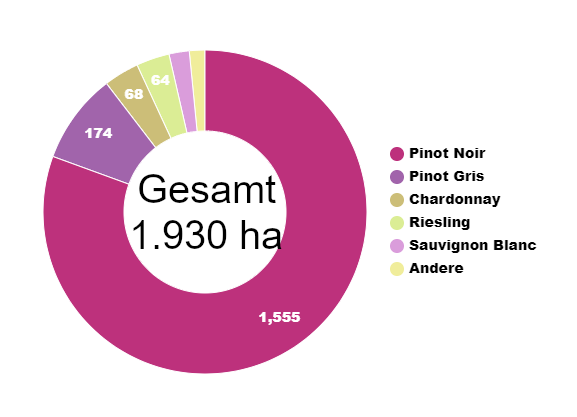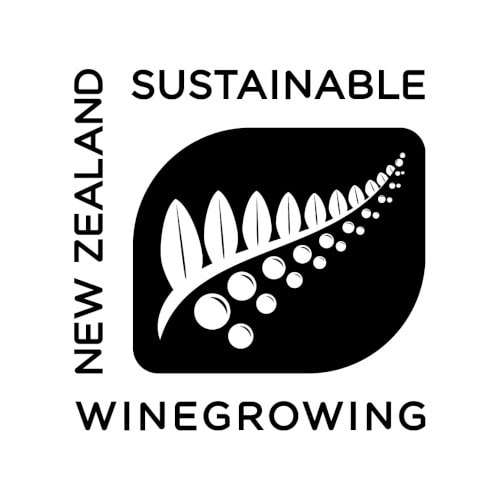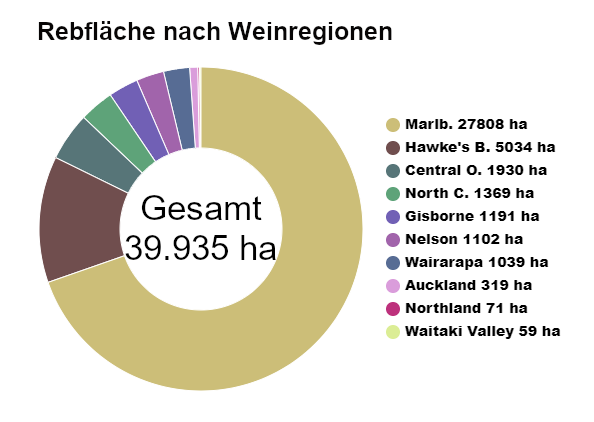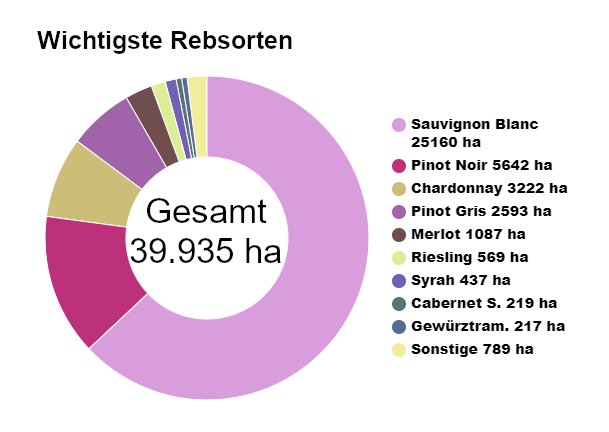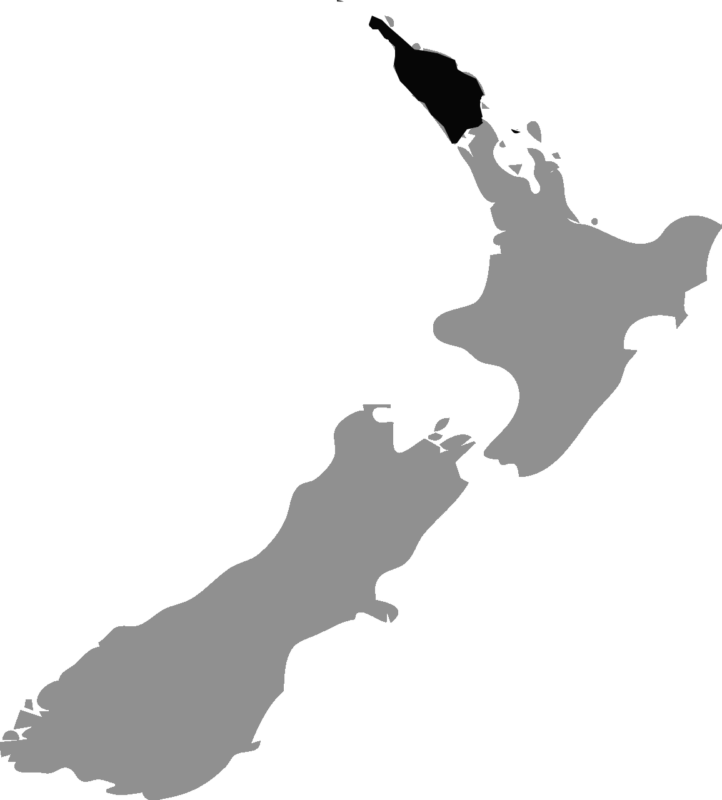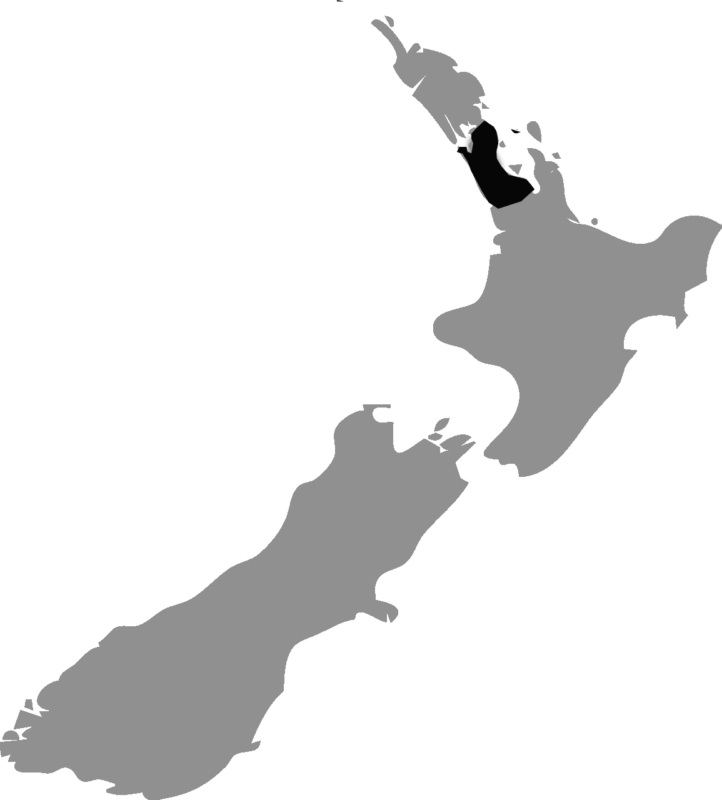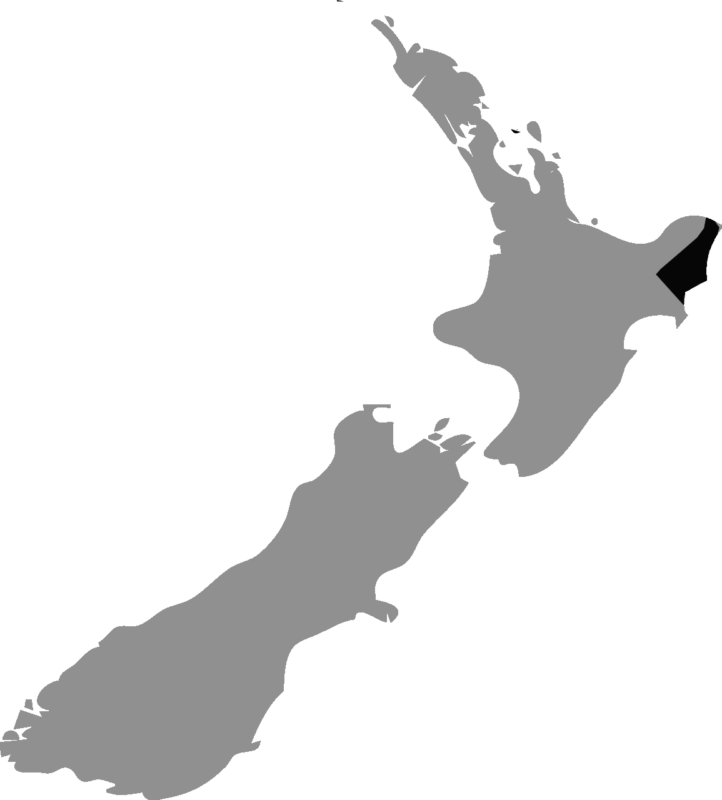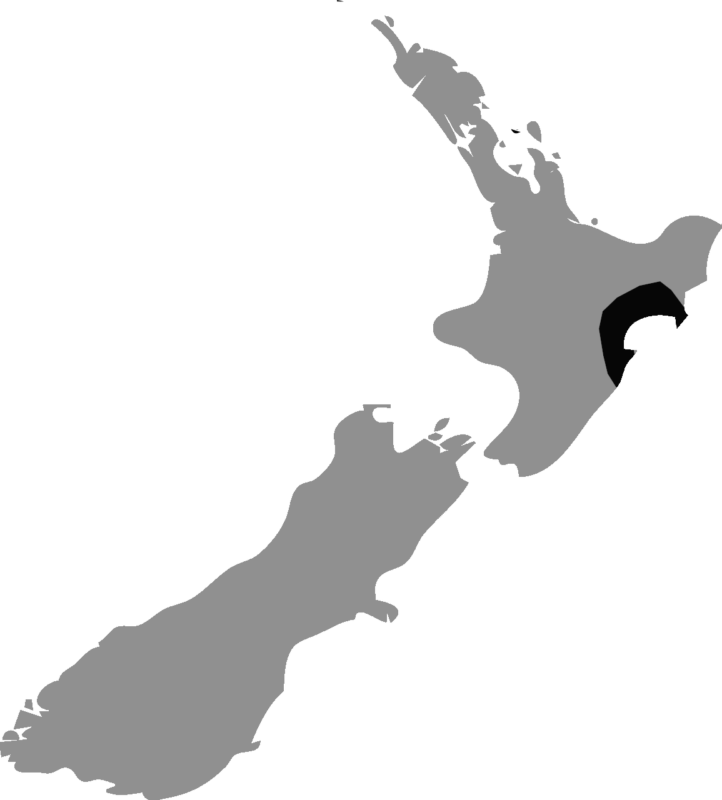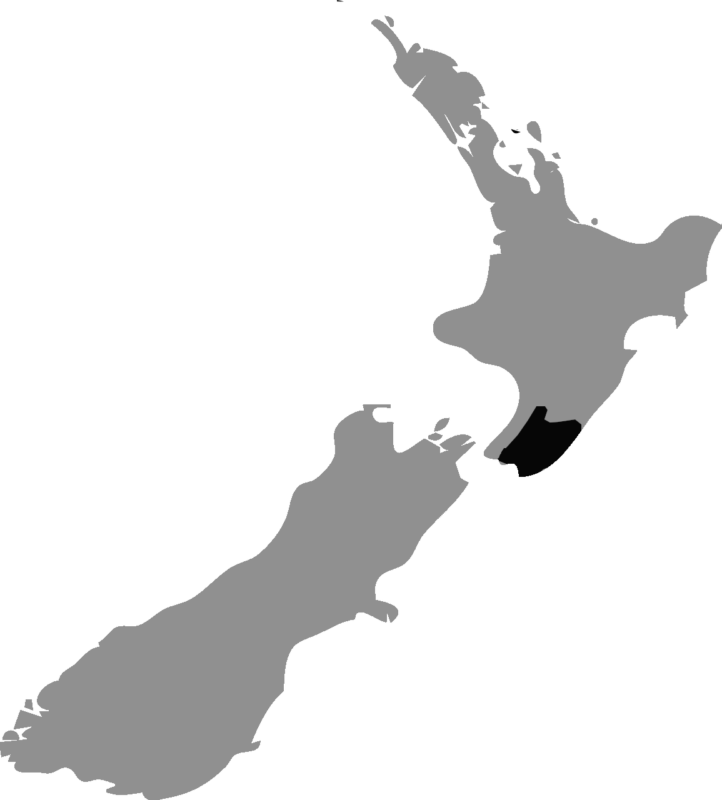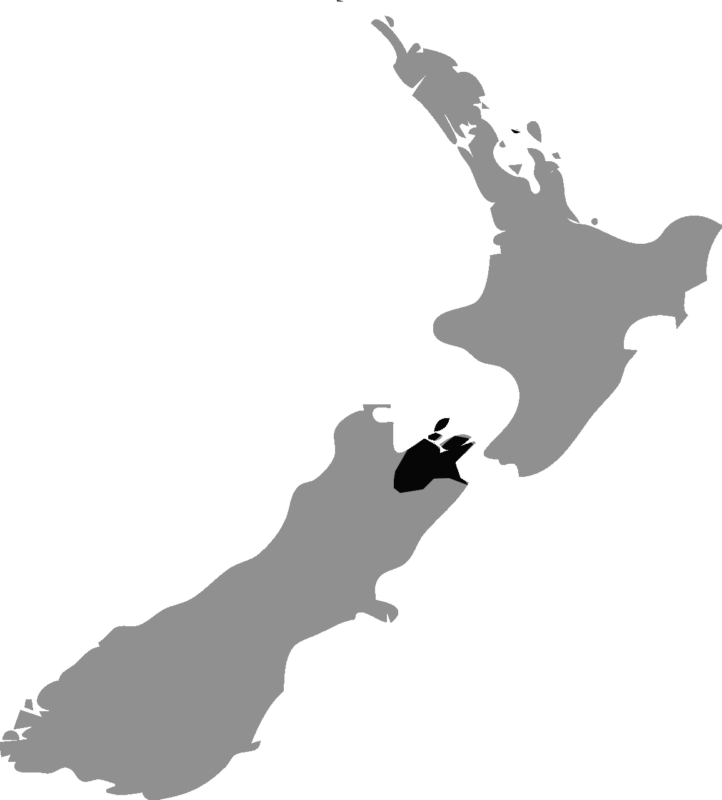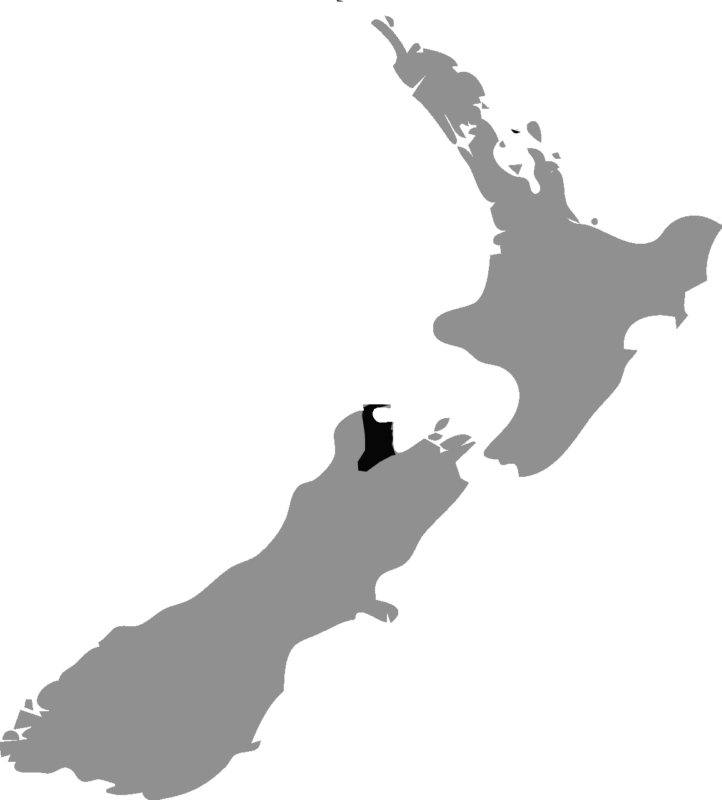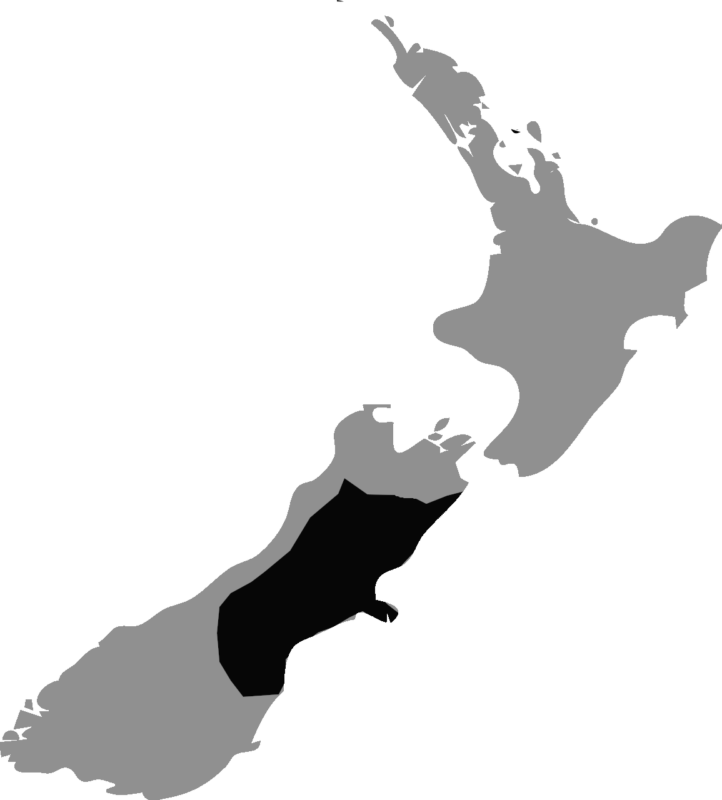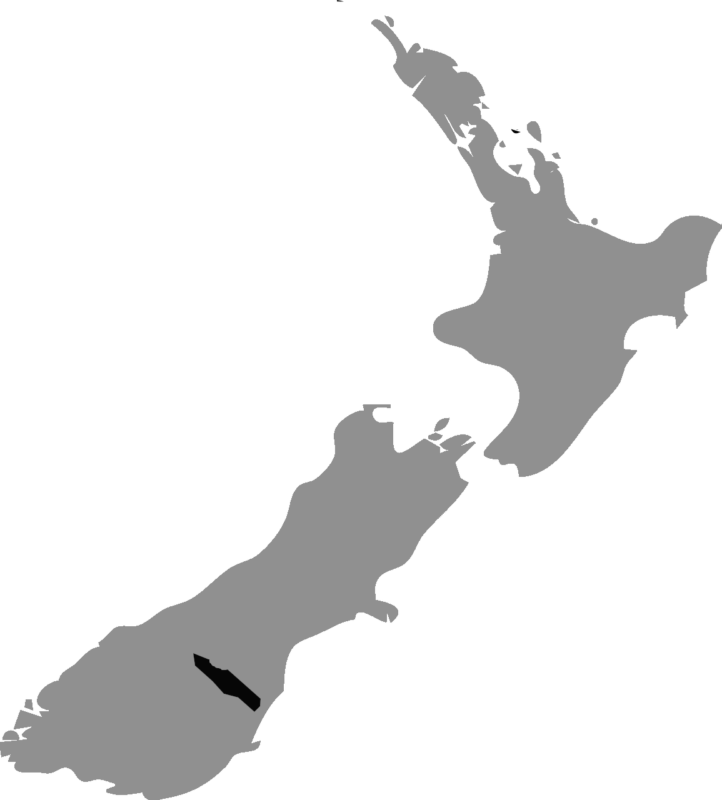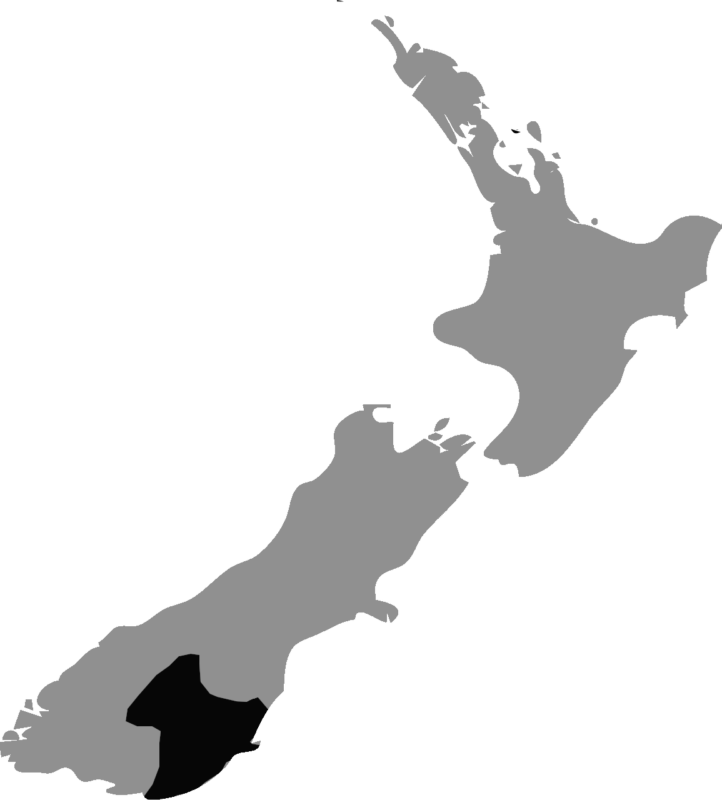The history of New Zealand wine
Abel Tasman, a Dutch explorer, was the first European to reach New Zealand in 1642. But it was the British navigator and explorer James Cook (1728-1779) who took possession of the two islands for the United Kingdom in 1769 and heralded the colonisation of the country. It was not until 50 years later that New Zealand’s actual wine-growing history began. In 1819, Samuel Marsden, a missionary, planted the first one hundred vines. He had brought them with him from Australia and planted them in the garden of the mission station near Kerikeri, a town on the north-east coast of the North Island.
The first documented New Zealand wine was pressed by the Scotsman James Busby in the 1840s. The grapes came from a small vineyard he had enthusiastically planted in Waitangi. His success encouraged others to plant vines and produce wine. Immigrants from Europe played a significant role in New Zealand’s viticultural history. Croatian families, in particular, were among the most important pioneers of viticulture in New Zealand. They were responsible for the founding of such renowned wineries as Nobilo and Montana Wines.
Romeo Bragato, an Italian oenologist and later state viticulture director, defined the best areas and locations for growing grapes. This was preceded by numerous journeys and analyses. He also distinguished himself in the fight against phylloxera, which reached New Zealand in 1895 and destroyed many vineyards there. One countermeasure was the planting of more resistant, phylloxera-resistant hybrid vines. These were brought from America to replace the disgraced European Vitis vinifera vines. Unfortunately, it was not until later that the quality of the hybrids, such as the red grape variety Isabella, was noticed to be inferior. Thus, in the 1960s, there was finally a renaissance of the Vitis vinifera varieties and thus a return to the production of quality wines. As a result, there was also a shift from fortified wines (fortified wines similar to Port and Madeira) to table wines.
The development of New Zealand viticulture was also slowed down by Prohibition. This alcohol ban was passed by referendum at the end of the 19th century and lasted until the 1970s. Until that time, wine consumption in public was prohibited in public transport, theatres and airports, among other places.
But strong investment from overseas companies, mainly from Australia and America, accelerated the growth of New Zealand’s wine industry. Until 1973, viticulture only took place on the North Island. But this changed abruptly when the Montana winery settled in Marlborough and showed the potential of this region for the Sauvignon Blanc grape variety. Today, Marlborough is the largest wine-growing region in New Zealand with Sauvignon Blanc (planted in 1975) as the premium variety.
NORTHLAND – THE STORY
As the name suggests, Northland is the northernmost region of New Zealand. The wine growing areas stretch from Karikari in the north to Mangawhai in the south. Northland’s long, narrow shape means that it is nowhere more than 50 kilometres from the ocean.
The ocean, and its northerly latitude, provides a subtropical climate often found in New Zealand. In addition, Northland’s soils, vineyards and microclimates are unique, creating a variety of wine styles from a wide range of grape varieties. Vineyards are generally located in the coastal areas around Whangarei, the Bay of Islands and Kaitaia to take advantage of the flatter coastal land and mild sea breezes.
Northland has a long history of viticulture. The first vines were planted in the Bay of Islands in 1819 by missionary Reverend Samuel Marsden. Plantings remained relatively small until the late 1800s when Croatian immigrants arrived and established New Zealand’s first wine industry. Initially, the first wineries focused on trading fortified wines, a style that suited Northland’s ripe, flavourful grapes well. Many of today’s producers across New Zealand can still trace their roots back to Northland.
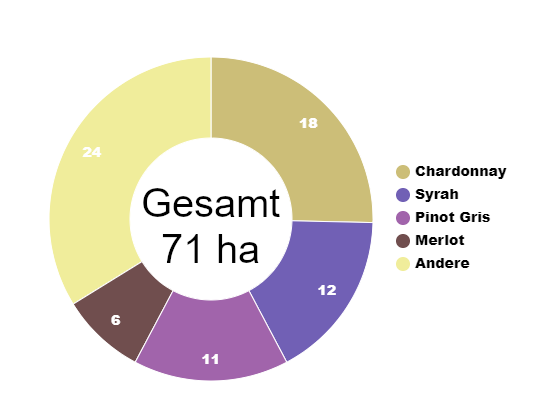
THE SOILS IN NORTHLAND
Northland’s vineyards are planted on very diverse soils. This is not surprising for a region that has such a long, narrow and varied topography.
Northland has more than 220 soil types, a significant difference from other New Zealand regions which typically have around 20. Because of the small number and the relatively dispersed locations of growers, the sub-regions in Northland are not yet clearly defined. As such, it is difficult to generalise about the influence of soil on wines. However, heavy clay and free-draining volcanic soils are relatively common throughout the region. The subsoils are generally compact loams.
AUCKLAND – THE STORY
A large, important and very diverse region, home to New Zealand’s largest wine producers and tiny boutique wineries. The Auckland wine region covers a large, geographically diverse area. The wine region includes the distinctive vineyard island of Waiheke, the historic West Auckland sub-regions of Kumeu, Huapai and Waimauku. It extends north to the coastal enclave of Matakana and south to Clevedon’s rolling hills. Award-winning Gewürztraminer is even pressed near Auckland International Airport.
These areas were established in the early 1900s by Croatian, Lebanese and English winemakers whose heritage and names persist today: Babich, Brajkovich, Corbans, Delegats and Nobilo, to name a few.
Although it is difficult to generalise about such diverse terroirs, the sub-regions do have a few things in common: volcanic, clayey soils, a temperate maritime climate and proximity to New Zealand’s largest and most economically important city. The Auckland wine region is primarily home to powerful, intense reds, red blends in the north and on Waiheke Island, where there is also exciting Syrah, as well as world-class Chardonnays.
THE SOILS OF AUCKLAND
Auckland’s history of volcanic activity has overlaid the ancient rocks with much younger material. Over thousands of years this material weathered to form predominantly clay soils, although sandstone, siltstone and windblown siltstone are also common. As the soils generally provide quite poor drainage, the selection of suitable clays has important significance.
Kumeu
An area steeped in history that produces some of the best wines in the country. A trip ‘west’ is a must for wine lovers. Fertile soils and warm, humid weather are challenging, but experience counts and many wines regularly win international awards. Chardonnay and Merlot are the highlights, although the range is broad. Some larger wineries also source grapes from other regions to keep up with supply.
Waiheke Island
Waiheke’s picturesque island location has a unique terroir. The warm, dry maritime climate promotes intensity, varietal depth and purity of fruit. Syrah is a rising star, fresh, elegant and silky, although a range of other varieties from Montepulciano to Petit Verdot, from Chardonnay to Viognier also perform very well.
Matakana
About an hour’s drive north of Auckland, Matakana has pretty rolling hills and is an inviting area for wine tourists. The vines are relatively young but produce stylish pinot gris, elegant syrah and bold reds. The climate is mild and humid, a test for the winemakers, but careful site selection and vine care produce spicy wines with muscular body.
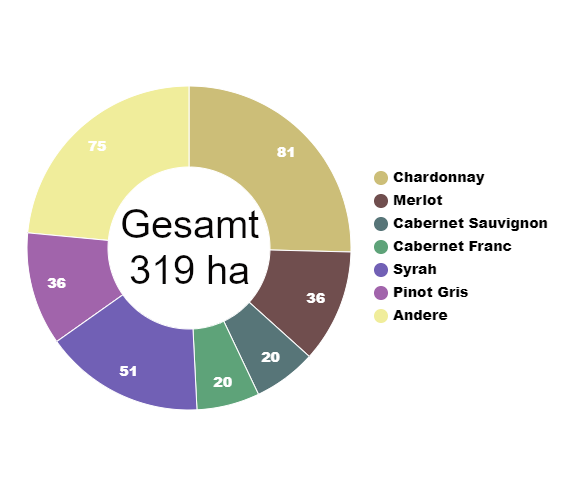
Gisborne – The Story
The mix of plenty of sunshine, verdant landscapes, fascinating history a relaxed lifestyle and an exciting range of wine styles makes Gisborne a beguiling destination for wine travellers. Those who make the journey east will be rewarded with a diverse selection of wines. From tasty entry-level wines to critically acclaimed biodynamic classics. A modern food and wine culture scene completes the picture.
Gisborne is rich in history and can claim to have been the site of Captain Cook’s first landing. Vines were first planted in the 1850s and the modern wine industry established itself from the 1960s when Montana, Penfolds and Corbans Wines built wineries. Large producers are still present, but Gisborne is shaking off its history of mass production. Small quality producers and innovative winemakers experimenting with new varieties and sites point to its future.
Chardonnay is the dominant variety and enjoys great success, although a very wide range of red and white varieties have been successfully established. New varieties are constantly being tested. The hillside sites are being discovered more and more and planted with new varieties and clones. The renaissance of Gisborne is in full swing.
The soils of Gisborne
The youthful, very hilly landscape fans out into two sub-planes. The lush floodplains of the Waipaoa River, characterised by a mixture of clay and silt loam, and the heavier clay soils on the plains. However, site selection is increasingly moving away from the very fertile flood loams towards the higher, better drained parts of the plains and their foothills.
Manutuke
Vines were first planted there in the 1890s. South of the city, closer to the coast and under the influence of sea breezes. Well-drained sandy and silty soils with slightly heavier, complex kaiti clay in the hillier west are the norm. Ideal for Chardonnay. Closer to the river, conditions can be ideal for botrytised wines as well as finely textured aromatic wines.
Patutahi
About a third of the vines in the entire region are here, a result of Montana’s strong expansion. Patutahi’s warmer inland location, west of the city, is characterised by low rainfall and well-draining, sloping clay and silt soils. Very good Gewürztraminer comes from here, full of flavour and with good texture and body.
Ormond
North of town, where the river valley narrows into the Raukumara Ranges, are Gisborne’s most pristine plantings. It is warmer, slightly drier with predominantly silty loam. Some of the best wines are produced here, often as single vineyard wines. It is also home to ‘The Golden Slope’, a 10km long, gently sloping, free-draining, sandy escarpment with limestone-influenced topsoil. Some of Gisborne’s best Chardonnay wines come from this site.
Central Valley
The Hexton Hills, between the Ormond Valley and the town of Gisborne itself, feed into the Central Valley sub-region. These hills consist of a narrow strip ranging from heavy clay in the Ormond and Hexton Hills, to limestone in the foothills. On the other side of the valley to the Waipaoa River, the Central Valley consists of a mixture of clay and silt soils.
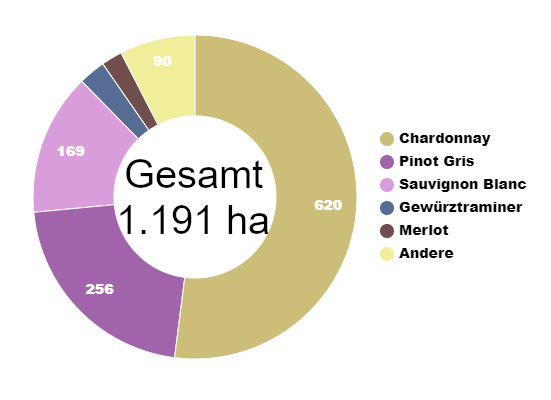
Hawke’s Bay – The Story
New Zealand’s second largest wine region. Sunny Hawke’s Bay has been a rich source of fine wine since 1851. Professionally designed wine tourism trails showcase the region’s beautiful Art Deco architecture (especially in the city of Napier) and allow you to visit Hawke’s Bay’s mostly artisan wine producers.
Hawke’s Bay’s mild climate and high sun intensity make the region ideal for growing grapes and fruit. The first vines were planted by Marist missionaries in 1851. The historic mission winery in Taradale is a reminder of this. The region now enjoys a significant international reputation for producing some of New Zealand’s finest red and white wines. The region is particularly known for its Red Blends and Chardonnay, but the aromatic whites and Syrah also succeed consistently well.
The climate and the long growing season also allow for the regular production of characterful dessert wines. New grape varieties are constantly being tested. The numerous wineries include both large, multi-regional entities and small, family-run boutique wineries. All share a commitment to making great wine. With its long history and green, productive landscape, Hawke’s Bay is synonymous with an outstanding wine tourism culture and offers a wide range of cellar tours, wine tastings and regular food and wine festivals. At Cellardoor24 you can now order New Zealand wines from the Hawke’s Bay region online.
The soils of Hawke’s Bay
Four major rivers have shaped the soils of the region. Hawke’s Bay is a virtual kaleidoscope of soil types, which has a significant impact on viticulture and wine styles. The densely planted plains are alluvial over gravelly subsoils: Havelock has more sandy loams over clayey pans, while Hastings is surrounded by clayey clays. The ferruginous reddish, dry and stony soil of the Gimblett Gravels is famous; the surrounding hill country on the other hand, is clay and limestone based. Bridge Pa contains the oldest soils on the Heretaunga Plains. These are very distinctive as they consist of low fertility, free draining alluvium, sediments or eroded ash, loess and underlying sediments.
The coastal areas
Although the maritime influence of the Pacific Ocean extends into much of Hawke’s Bay, the two wine-growing areas directly on the coast benefit most from the temperate climate and long growing seasons. The gravelly soils of Bay View in the northern Esk River Valley area and Te Awanga in the south are predestined for premium Chardonnay and early-maturing reds, including Pinot Noir.
Alluvial plains
Created early and now largely planted with vines, the plains vary in soils and mesoclimate as much as in grape varieties and styles. Shaped by rivers and criss-crossed by gravel beds, free-draining alluvial soils and stony terraces, they fan out between Havelock and Napier, covering the pioneer vineyards of Taradale and Meeanee, and the Gimblett Gravels and Bridge Pa Triangle inland, home to some of the region’s finest wines.
Mountain vineyards
These are becoming increasingly interesting because of the different soils and altitudes. The slopes also protect the inland sites from frost. They are mainly planted with red varieties. The hillside sites in the sub-regions of Maraekakaho and Bay View produce top wines.
River valleys
Vier Flüsse haben die im Laufe der Zeit eine große Vielfalt von Weinanbaugebieten geschaffen. Sie laufen quer durch Hawke’s Bay, von den schützenden Gebirgszügen im Westen bis zum Meer im Osten. Die Weinberge dort haben geschützte Umgebungen, mit Variationen in Höhe, Ausrichtung zur Sonne und eine große Bandbreite an Böden. Feine Weine kommen von den höher gelegenen Lagen: erstklassige Chardonnay, Sauvignon Blanc, Pinot Gris und Pinot Noir.
Central Hawke’s Bay
At an altitude of up to 300 metres are the vineyards of Central Hawke’s Bay. They tend to be somewhat cooler and offer good conditions for Sauvignon Blanc, Pinot Gris and Pinot Noir.
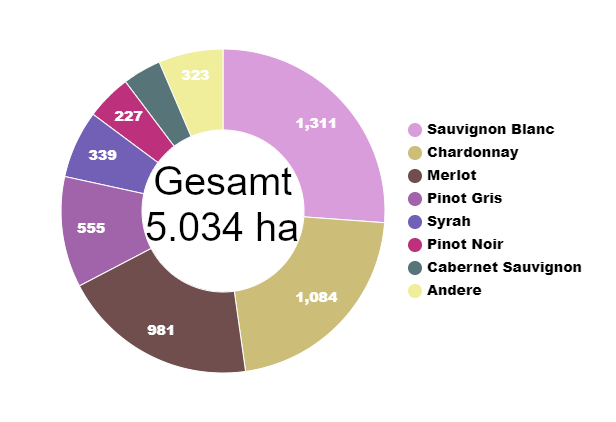
Wairarapa – The Story
Wairarapa, which means ‘sparkling waters’ in the Maori language, is a diverse region with a multitude of boutique wineries. Here, supported by an ambitious wine community, high quality wines are produced from a wide range of grape varieties.
The three main sub-regions of Martinborough, Gladstone and Masterton share broadly the same climate and soils, yet show subtle differences in the character of the wines. A range of wine styles and varietals is available from Pinot Noir, Sauvignon Blanc and Aromatics to stylish Chardonnay, Syrah and dessert wines.
The first settlers planted the first vines as early as 1883, but these fell victim to the temperance movement in 1905. Wairarapa’s modern wine history began in the late 1970s when wineries such as Dry River, Martinborough Vineyard, Ata Rangi and Chifney (now Margrain) established vineyards in Martinborough. Wairarapa accounts for only about 3 per cent of New Zealand’s vineyard area and 1 per cent of total production, yet it is home to some of New Zealand’s best-known and most popular producers.
Only about 30 kilometres from Wellington and the sea, Wairarapa offers a range of wine tourism attractions and amusements, as well as a variety of unique accommodation and restaurants.
The soils in Wairarapa
Predominantly silty loam over free-draining gravel. Some of the gravel banks can be up to 15m deep thanks to the rivers that cross the region. Clay and limestone occur in some specific vineyards and winemakers work hard to match their varieties with the soil profiles. Particularly prominent are the gravelly riverbeds of Masterton, with some limestone zones, Gladstone’s silty loam with clay inclusions, and the shallower river terraces of Martinborough and nearby Te Muna.
Masterton
Masterton is the largest town in Wairarapa and it was the first area to cultivate grapes over a hundred years ago. The valley lies in the shadow of the Tararua Mountains. Early morning frosts are common here, contrasted by incredibly hot summer days. Diurnal temperature variations produce complex and flavourful wines, with Sauvignon Blanc and Pinot Noir as the dominant varieties.
Gladstone
Located just south of Masterton, Gladstone is blessed with well-drained river terraces and a cooler climate with plenty of sunshine. It is a fast growing sub-region with room to expand. Loam beneath the stony silt loams goes very well with the predominant Pinot Noir, vibrant Sauvignon Blanc and impressive aromatics. The well-known and popular Harvest Festival in March showcases Gladstone’s fruits of labour.
Martinborough
The southernmost sub-region, with well-drained soils and a cool, dry climate. The town of Martinborough is a picturesque colonial village surrounded by vineyards. The wine scene is dominated by small, often family-run wineries and the climate and soil profile are similar to Burgundy. It’s no wonder, then, that Martinborough has often wowed the wine world. Universally acclaimed Pinot Noir, vibrant Sauvignon Blanc, elegant Syrah and other great growths are produced here.
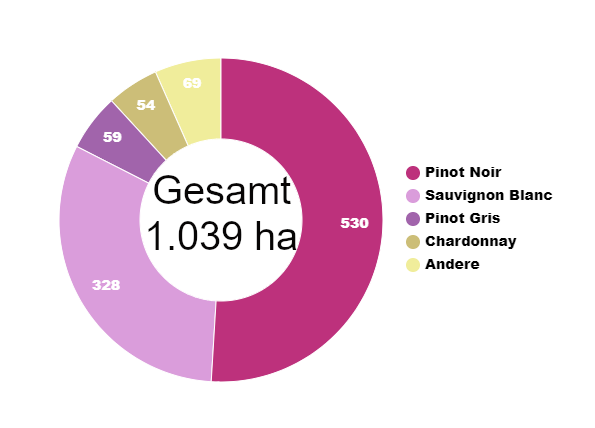
Marlborough – The Story
New Zealand’s flagship wine region. In combination with Sauvignon Blanc, it brought the country onto the international wine stage. However, this region is much more than just Sauvignon. Marlborough offers increasing depth in both varieties and terroir.
Early pioneers first planted vines in the Ben Morven Valley in 1873. More vineyards were planted until the 1960s. After that, there was a lull until 1973 when vines were planted again, against fierce opposition from local agriculture and forestry.
Today, viticulture dominates with over 20,000 hectares of vines, which is about two-thirds of the national vineyard area. Marlborough is considered one of the sunniest and driest regions in New Zealand. The Maori called the Wairau Valley ‘Kei puta te Wairau’, which means ‘the place with the hole in the cloud’. This alludes to the excellent protection offered by the topography. The Wairau River bisects the valley from west to east, with the Richmond Ranges to the north and medium-sized foothills to the south. The favourable combination of cool but sunny climate, low rainfall and free-draining, moderately fertile soil produces uniquely vibrant wines in a wide range of varieties and styles. Now you can buy New Zealand wines from the Marlborough region online.
The soils of Marlborough
Key to Marlborough’s success are the ancient, glacial-era, free-draining, stony soils. The extensive branching river system has a ramified heritage of stony, sandy loam over very deep gravels. Rapaura is the stoniest; the lower Wairau has more clay and thus water retention. Clay is predominant in the southern valleys. Valleys, which supports Pinot Noir. Awatere is more fragmented,
with gravelly silt loam and windblown loess.
Wairau Valley
Old riverbed and riverbank soils dominate. Different aspects and rainfall result in many micro-climates within this sub-region. Broadly, it includes cooler, drier inland sites, barren, stony, early maturing sites to coastal sites tempered by sea breezes. The soils tend to be gravelly in the north, closer to the riverbed. The wines reflect the individual strengths of the vineyards the strengths of the individual sites and producers, but all have a characteristic pure intensity and body.
Southern Valleys
Surrounded by rolling hills, the Omaka, Fairhall, Brancott, Ben Morvan and Waihopai valleys make up this important sub-region. Soils vary but tend to be heavier and loamier than in Wairau. To the south of the valleys it becomes cooler and drier. A wide range of wines are grown, depending on the individual strengths of the vineyards, with some particularly good Pinot Noir, Gewürztraminer and Pinot Gris.
Awatere Valley
The most geographically distinctive sub-region, lying south of the Wairau Valley and extending inland from the ocean. The valley rises sharply towards the Kaikoura Ranges. It is cooler, drier, windier and often characterised by lower yields. Light-footed, aromatic Pinot Noir and spectacular, distinctive Sauvignons are produced, which are increasingly gaining international recognition.
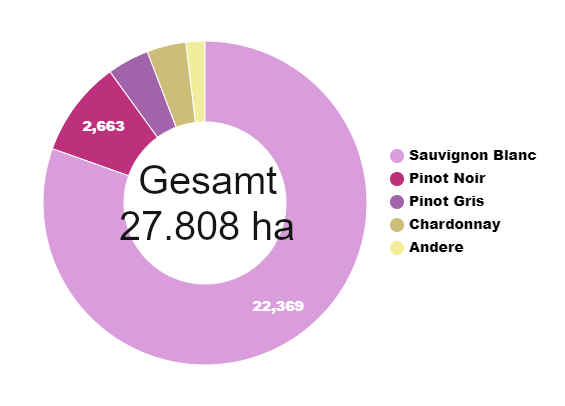
Nelson – The Story
Beautiful, sunny Nelson is a must-see for any wine lover. The tiny but thriving wine production perfectly illustrates the region’s long history of horticulture and artistic endeavour. Nelson has a gentle, sunny climate and spectacular scenery ranging from golden sandy beaches to rugged, bush-clad mountains. Grapes are grown in the Moutere Mountains and on the Waimea plains.
Production is small, but the overall quality is impressive, including some superlative highlights. The region has long been known for its vineyards and orchards. First vines were planted and cultivated by German settlers in the 1800s. But it was the pioneers of the 1970s who established the modern wine industry. Their names, such as Seifried and Neudorf, are still going strong.
Today, Nelson produces excellent Pinot Noir, Chardonnay, Sauvignon Blanc and Aromatics. In addition, this region has a vibrant art and café culture. Many wineries like to combine these attractions with cellar tours and tastings. The manageable size of the region means that visitors can visit most wineries in a day. So the two-hour drive from Blenheim is well worth it. However, you can also buy New Zealand wines from the Nelson region online at Cellardoor24.com
TO THE WINES FROM THE NELSON REGION
The soils in Nelson
The regional soils are largely gravelly silt loam over a clay layer that allows for good water holding capacity. The two main areas vary slightly in composition. The alluvial, shallow
silty soils of the Waimea Plains generally produce lighter, graceful wines. The gently rolling Moutere Hills, where the weathered gravels of an ancient river system lie beneath sandy, heavy clay soils, give depth and richness to the wines.
Moutere Hills
To the west of the city lie the green Moutere Hills. They are slightly warmer and wetter than Waimea and the pebble-strewn clay soils give the wines richness and texture. Pinot Noirs with structure and fine tannins, Chardonnays with complexity and depth, Sauvignon Blancs with mineral intensity are produced. This is where Nelson’s early pioneers planted vines and it remains the source of some of the best wines.
Waimea Plains
Waimea is the Maori word for “river garden”. This traditional area for farming, orchards and hops records most of the recent vineyard expansion in Nelson. Characterised by stony alluvial soils and a moderating maritime influence, the wines tend to be lighter and fresher in style than those from the Moutere Hills. The Pinot Noir is intensely aromatic, the Chardonnay rich and expressive, with distinct mineral accents.
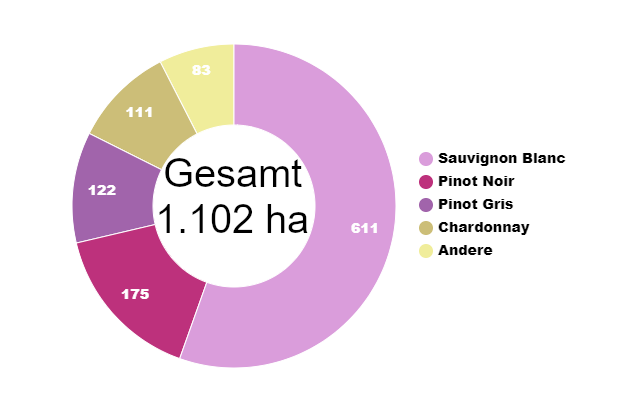
North Canterbury – The Story
Where the Southern Alps meet New Zealand’s expansive lowlands, boutique producers produce outstanding Pinot Noir, Riesling and Chardonnay and much more. The area covers almost 200km of the South Island’s eastern coastline, with the Southern Alps to the west and the vast Pacific Ocean to the east. The Waimate vineyards mark the boundary to the south and Cheviot to the north. The area also includes the Banks Peninsula, with its own microclimate.
The North Canterbury wine region offers a diverse range of styles and producers, as well as many attractive wineries. Wine production first began on the Canterbury Plains near Belfast in 1978, followed by vineyards in the south-west and north of Christchurch. North Canterbury is now intensively planted and wines from the region regularly receive good reviews for their individual, sub-regional character. Explorations of new areas inland towards Weka Pass are promising.
The cool, dry climate with good sunshine and the long growing season promote the full development of the grape varieties. The wines are known for their intense aromas, richness and complexity. Order New Zealand wines from the North Canterbury and Waipara region online now.
TO THE WINES FROM THE NORTH CANTERBURY AND WAIPARA REGION
The soils in North Canterbury
As is to be expected with large and varied terrains, soil types vary significantly. The northernmost plantings in the region benefit from gravel deposits from the river of the same name, as well as chalky clay layers on the slopes, which are suitable for Pinot Noir.
The vast, flat North Canterbury Plains around Christchurch
consist mainly of shallow, free-draining, stony soils with alluvial deposits. They derive from the many branching river systems that cross the plains.
Waipara Valley & Waikari
An exciting, fast-growing sub-region about an hour’s drive north of Christchurch that produces vibrant, elegant Rieslings. The soils are gravel and clay. As sites and meso-climates are explored, more distinctive Pinot Noir and Chardonnay are emerging. Although the dry north-westerly (nor’wester) winds can be challenging, the surrounding hills offer shelter and a slightly warmer climate than the rest of the region.
Banks Peninsula & Canterbury Plains
A large area under vines from the Banks Peninsula on the outskirts of Christchurch. It extends west from Rolleston and West Melton, north towards Waipara. The vines are on predominantly flat or very gently rolling land with well-drained, shallow gravel soils on a greywacke base. The climate there is somewhat cooler than in the more sheltered northern areas. Riesling and Riesling and Pinot Noir are the highlights, with the longer growing season producing graceful, expressive wines.
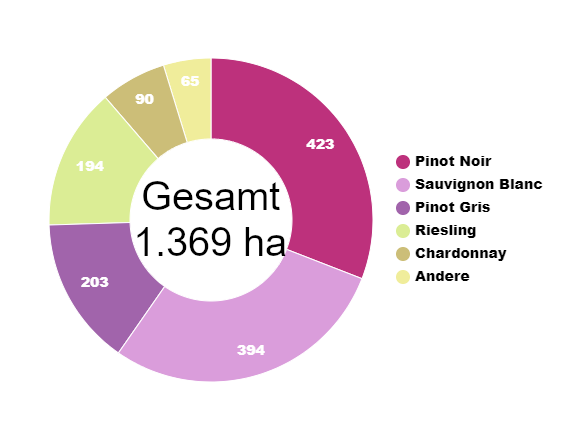
Waitaki Valley/North Otago – The Story
The sub-region of North Otago, the Waitaki Valley, has caused a stir that goes far beyond its tiny size. It is still a very young winegrowing region, the first vines were only planted in 2001. It is the complex, promising soils of limestone, greywacke and slate and the very cool climate with a long, dry growing season that have attracted adventurous and ambitious winemakers.
The area is about 20 km inland from the mouth of the Waitaki River, on the border between North Otago and South Canterbury. It is similar in varieties and wine styles to the neighbouring Central Otago wine region, but subtle differences in climate and soils give the Waitaki Valley and its wines a signature of their own.
Highly aromatic, delicately structured wines with pronounced but balanced acidity and very pure, expressive varietal character are produced here. Right up front, Pinot Noir, the predominant variety, sets the tone alongside aromatic white wines made from Pinot Gris, Riesling and Gewürztraminer, as well as some Chardonnay and other white varieties. Viticulture on the borderline, there is little room for error. Carefully selected vineyard sites and yield reduction are essential. Yet Waitaki Valley wines have delighted those lucky enough to find them. and it is clearly a region to watch as its potential unfolds.
The soils of the Waitaki Valley
The Waitaki Valley is essentially a geographical link between the
between Central Otago and the east coast of the South Island. The soils are the legacy of a long, branching river system that meanders from the Southern Alps to the sea. Waitaki means ‘weeping water’ in the Maori language, and the wider area provides about 65 percent of New Zealand’s hydroelectric energy.
A distinctive feature of the region is the limestone, which was formed by an ancient geological fault line. This left a 38-million-year-old seabed along the river and a limestone-rich northern slope. Some winegrowers and winemakers recognised its potential, especially as limestone is a relatively rare type of rock in New Zealand.
Since colonial times, the Waitaki Valley area has been famous for its “Oamaru Whiteestone”, a highly prized building material that provided some of the most beautiful and enduring buildings in Otago and Canterbury. This unique feature is also found in the Waitaki limestone formations, the Elephant Rocks. The Elephant Rocks are just one of the impressive geological features of the region. There are also fossils of shark-toothed dolphins, the stunning Clay Cliffs and the remarkable Moeraki Boulder. All of these natural wonders can be explored by visitors via the Vanished World Trail.
The bedrock soils of the region have been shaped by tides, glaciers and rivers over thousands of years. Vineyards in the Waitaki Valley typically lie either on weathered limestone slopes or on now exposed former riverbeds of greywacke, shale and limestone river gravels. These very stony soils have an important heat storage capacity. They not only reflect heat, but also sunlight, which is important in a cool climate.
important in a cool wine-growing region with not many hours of sunshine.
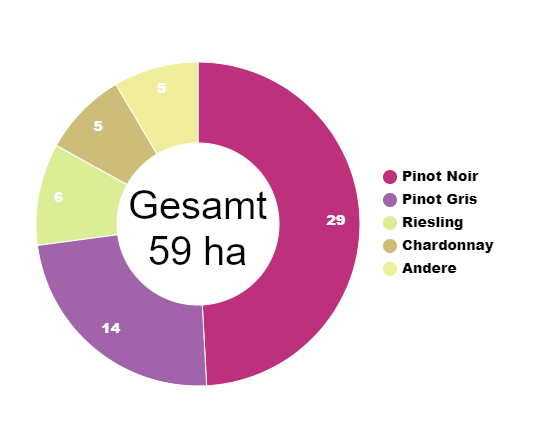
Central Otago – The Story
What a spectacular landscape. And home to some of the best Pinot Noirs in the world, not to mention stunning, vibrant white wines.
Historically, this region has been considered “eminently suitable” for winemaking since 1895. In fact, the first gold medal for a wine from this region was awarded as early as 1881. Nevertheless, fruit cultivation, especially of cherries and apricots, initially prevailed before interest in winegrowing was rekindled in the 1950s.
Significant investment then took place in the 1970s and the pioneering wineries of the time, such as Chad Farm, Rippon, Black Ridge and Gibston Valley, are still active in Central Otago today. The extreme climate rewards careful site selection with wines of great intensity and finesse. There is an increasing focus on individual sub-regions with distinctive mountainous terrain and unique niches due to climate, location and altitude.
Soils can vary considerably within each sub-region, although a stony, free-draining base is common to all. The remarkable landscape in the former gold mining area, with towering snow-capped mountains, deep gorges and sparkling rivers, attracts visitors from near and far. Order New Zealand wines from the Central Otago region online now.
TO THE WINES FROM CENTRAL OTAGO
The soils of Central Otago
A region formed by glaciers and now dominated by lakes, shaped by rivers and strong weather, offers a wide range of soils. Depending on the sub-region, there are soils of broken shale, clay, silt loam, gravel, windblown sands and loess. Common to all is good water drainage, as most are based on stony subsoils, with shale or greywacke bedrock.
Gibbston
East of Queenstown, along the spectacular Kawarau Gorge, lies Gibbston. The first commercial bottling of a wine took place here in 1987. It is the highest sub-region. Its cooler climate and north-facing vineyards allow the vines to ripen later than in neighbouring sub-regions, producing lighter yet intense wines.
Bannockburn
On the south bank of the Kawarau River, at the southern end of the Cromwell Valley, lie the vineyards of Bannockburn. It is one of the warmest and driest sites in the region. Harvest can be up to a month earlier than in Gibbston. Very characteristic and complex wines are produced here.
Cromwell, Lowburn, Pisa
This area is situated on the western side of Lake Dunstan and extends 25 km north of the parish of Cromwell. The majority of the plantings are on the lower terraces that run parallel to the snow-capped Pisa mountain range, producing silky, seductive wines.
Bendigo
Situated north-east of Cromwell, Bendigo is possibly the warmest of all the sub-regions. Vines are planted on gentle, north-facing slopes. Large plantings on stony soils defy the extreme climate with its hot summer sun and cold, clear nights.
Wanaka
This sub-region, 80 km and a few mountain ranges north of Queenstown, boasts one of the most picturesque vineyards in the world. It is cooler and slightly wetter than the Queenstown/Cromwell areas. The picturesque Lake Wanaka reflects sunlight and softens frosts, resulting in delicate and vibrant wines.
Alexandra
The southernmost sub-region. The climate is dry and runs in extremes in both summer and winter, but the marked diurnal variations through to harvest make for vibrant, varietal, aromatic and finely textured wines.
